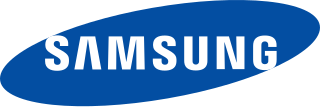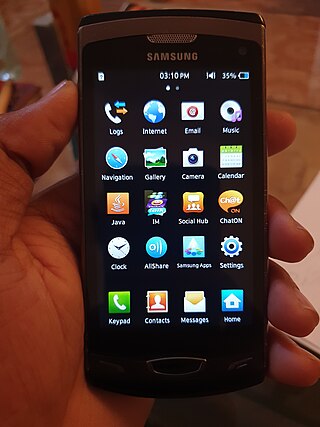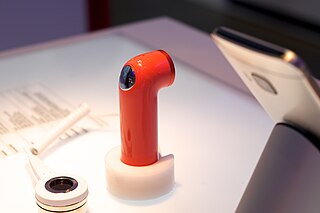Related Research Articles

The Nokia 7710 is a smartphone developed by Nokia and announced on 2 November 2004. It was the first Nokia device with a touchscreen, and first Nokia branded device with 2:1 aspect ratio display. The 7710 is based on the Nokia 7700 which was never released. It is Nokia's only smartphone to run the Series 90 interface atop Symbian OS v7.0s.

The Samsung GT-I7500 Galaxy is a smartphone manufactured by Samsung that uses the open source Android operating system. It was announced on 27 April 2009 and was released on 29 June 2009 as the first Android-powered device from Samsung Mobile, and the first in what would become the long-running Galaxy series. It is succeeded by the Samsung Galaxy S.

The Samsung Wave is a smartphone developed and produced by Samsung Electronics. It is the first smartphone to run the Bada operating system developed by Samsung Electronics, which was commercially released on May 24, 2010. The Wave is a touchscreen phone powered by Samsung's "Hummingbird" CPU (S5PC110), which includes 1 GHz ARM Cortex-A8 CPU and a built-in PowerVR SGX 540 graphics engine. It also has a "Super AMOLED" screen and 720p high-definition video capture capabilities. Due to shortage of Super AMOLED screens, Samsung released a successor to the device called Wave II and ceased production of the original S8500 model.
The Kyocera Zio is an Internet-enabled 3G smartphone manufactured by Kyocera, running Google's Android operating system.
The Helix Universal Media Server was a product developed by RealNetworks and originates from the first streaming media server originally developed by Progressive Networks in 1994. It supported a variety of streaming media delivery transports including MPEG-DASH RTMP (flash), RTSP (standard), HTTP Live Streaming (HLS), Microsoft Silverlight and HTTP Progressive Download enabling mobile phone OS and PC OS media client delivery.
The Nokia C6-01 is a Symbian^3 smartphone from the Nokia Cseries. The C6-01 display features comes with a 3.2in AMOLED display with capacitive touchscreen capabilities and Nokia's ClearBlack technology for improved outdoor visibility. The smartphone was released on November 4, 2010 for €260, excluding taxes and subsidies.

The Nokia C7-00 is a smartphone from the Nokia Cseries. It was introduced on 14 September 2010 and released in Q4 2010. The C7-00 features a 3.5-inch (89 mm), 640 x 360 pixel capacitive touchscreen and features 720p video recording, and was also the world's first smartphone to have NFC capability. Nokia's mobile phone business head Anssi Vanjoki called it the "sleekest" device in the world. Unlike the Nokia N8 flagship, the C7 has physical call and hangup buttons.

The Samsung Galaxy Player it was a line of Android-based all-purpose pocket computers produced by Samsung. The product was debuted on 2 September at the 2010 IFA in Berlin, and was showcased at the 2011 CES in Las Vegas.

The Samsung Wave II S8530 is the successor of the Samsung Wave S8500 smartphone running the Bada 1.2 operating system designed by Samsung, which was commercially released in October 2010. The Wave is a slim touchscreen phone powered by Samsung's "Hummingbird" CPU, which includes a 1 GHz ARM Cortex-8 CPU and a built-in PowerVR SGX 540 graphics engine, "Super LCD" display and 720p high-definition video capture capabilities.SlashGear speculated that the phone could be the result of a rumored AMOLED panel shortage.

The Samsung Infuse 4G it was an Android smartphone that was released by Samsung in May 2011. It has a 1.2 GHz Hummingbird processor with 8–16 GB internal Flash memory, a 4.5 inch 480×800 pixel Super AMOLED Plus capacitive touchscreen display, an 8-megapixel camera and a 1.3-megapixel front-facing camera.

The Motorola Milestone XT720 is an Android-based smartphone manufactured by Motorola Mobility, originally released in July 2010. Announced in June of that year, it was the first Motorola Android phone with xenon flash.
The Samsung Galaxy R (Royal) (GT-I9103) is an Android smartphone that was announced by Samsung on August 10, 2011 as a variant to the Samsung Galaxy S II.

Samsung Galaxy W (i8150), also known as Samsung Wonder, is an Android smartphone that is a smaller-sized variant of Samsung Galaxy S II.

The Samsung Galaxy S LCD or Samsung Galaxy SL (GT-I9003) was an Android smartphone designed and manufactured by Samsung Electronics that was released in February 2011. It features a 1 GHz ARM Cortex-A8 processor, 4 GB of internal flash memory, a 4-inch 480x800 pixel WVGA Super Clear LCD capacitive touchscreen display, Wi-Fi connectivity, a 5-megapixel camera with a resolution of 2560x1920, and a front-facing 0.3 MP (640x480) VGA camera.

The HTC Salsa is an Android smartphone that was announced by HTC in June 2011 at the Mobile World Congress.

The HTC RE Camera is a camera introduced by HTC in 2014. It offers a 16MP sensor supporting 1080p video capture, intrusion protection, and is able to connect with smartphones through a dedicated application. Reception to the camera has been mostly positive.

Samsung's Galaxy A5 (2016) or Samsung Galaxy A5 2016 Edition is an Android smartphone developed by Samsung Electronics as part of the Samsung Galaxy A series.
Vivo X7 is an Android smartphone developed by Vivo Communication Technology Co. The phone was initially released in June 2016. It has a 5.2 in (13 cm) display, a 3000 mAh battery, and 13 and 16 MP cameras.
The Samsung Wave III S8600 is a smartphone running the Bada 2.0 operating system designed by Samsung, which was commercially released on August, 2011. The Wave is a slim touchscreen phone powered by "Scorpion" CPU, which includes 1.4 GHz ARM Cortex-8 CPU and a powerful graphics engine, "Super LCD" screen and 720p high-definition video capture capabilities. Shortage of Super AMOLED screens was one of the primary reasons for the release of this model.

The Samsung Galaxy Z Fold 4 is a foldable smartphone that is part of the Samsung Galaxy Z series. It was announced at the August 2022 edition of Galaxy Unpacked alongside the Galaxy Z Flip 4. It was released on August 25, 2022. It is the successor to the Galaxy Z Fold 3.
References
- ↑ "Kyocera Hydro C5170". gsmarena.com. Retrieved 13 June 2013.
- ↑ Kyocera Hydro (Boost Mobile) - PCMAG Review
- ↑ Kyocera Hydro Spec Sheet